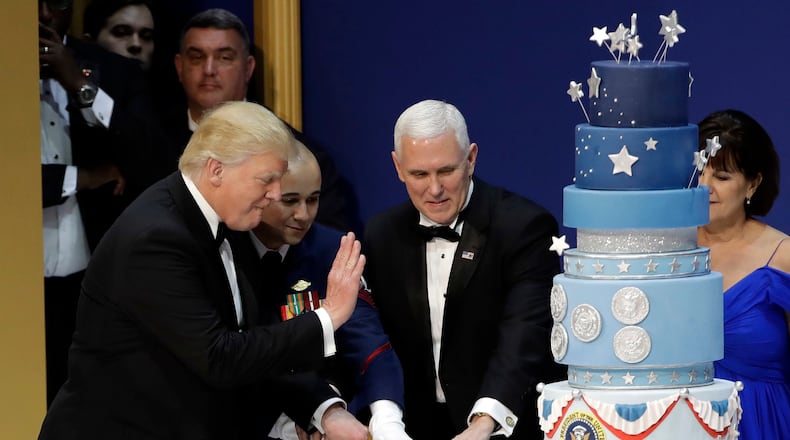I feel bad for Duff Goldman.
I wonder how this pastry chef who starred on Food Network’s “Ace of Cakes” felt last week when he realized that Donald Trump’s inauguration cake was a spitting image of the one he created for Barack Obama’s second inauguration. Did Goldman’s stomach churn? Mine did.
If you're not familiar with the social media moment dubbed #CakeGate, here's the gist: D.C. bakery Buttercream Bakeshop was commissioned by the Trump administration to create a cake for the president's inauguration. According to the Washington Post, Trump's organizers showed the bakery a photo of what they wanted: a nine-tiered cake from Obama's 2013 inaugural ball. Bakery owner Tiffany MacIsaac asked if perhaps they wanted something inspired by that cake rather than an exact duplicate. No, they wanted that same sweet thing. So the bakery made it.
The difference: Only the bottom layer was edible. The rest was made of Styrofoam.
That his cake was usurped was enough to get Goldman fired up on Twitter, where he posted side-by-side photos of the two cakes, with the comments: "The cake on the left is the one I made for President Obama's inauguration 4 years ago. The one on the right is Trumps. I didn't make it."
Later, after MacIsaac posted an image of her company's cake on Instagram and gave credit to Goldman, he tweeted the nicety: "Remembering a fantastic cake I made is awesome and the chef that re-created it for @POTUS Trump did a fantastic job. Group hug, y'all."
I wonder if Goldman needed to be so kind.
Some people would consider this plagiarism, something that we take seriously in the journalism world. If I were to take someone else’s article, slap my byline on it and send it to print, I would be fired.
And maybe that’s part of the problem in the culinary world. It’s hard to leave your signature, your byline, on an edible work.
In defense of MacIsaac of Buttercream Bakeshop, she did a few things right. She tried to encourage the Trump folks to settle on a cake that was inspired by, not a duplicate of, someone else's original, creative work. She donated profits to the Human Rights Campaign, but appeasing an act of appropriation through a charitable donation doesn't make it smell that much better. She also did give credit to Goldman on Instagram, but how many people would know to go to the bakery's Instagram account (@bttrcrmbakeshop) to see the credit?
So what are the “rules of engagement” here?
Apparently, that's been something on the mind a lot lately of Shaun Doty, co-owner and executive chef of Bantam + Biddy and the Federal. And it's something he talks to his staff about.
“There are three ways it goes down,” he began. “Say you work for Annie Quatrano at Bacchanalia for two years. You make crab fritters with citrus segments. That’s a classic Annie dish. She’s done that since when Bacchanalia was in a house on Piedmont. You open your own place and put it on the menu. That’s OK. You earned that. You pay homage to someone significant in your life. You’re allowed to do that.”
The next scenario he cited was when a chef eats out somewhere, enjoys a dish on a menu and offers it at his own restaurant. Doty noted that the sandwiches he serves at lunch at the Federal are a duplication of ones that wowed him at DiNic’s in Reading Terminal Market in Philadelphia. He called the ones at DiNic’s “the gold standard” and the ones at the Federal “an homage.” “I tell my staff to tell people that,” he said, adding, “The honesty and the transparency feel good.”
The no-no, Doty opined, was trolling the internet, social media platforms in particular, for ideas and then claiming the genius as your own. “You can’t go on Instagram and look at Sean Brock’s Instagram account and put chicken skin on something and claim that it’s your own. That’s not cool. That’s the problem with Instagram. That’s where plagiarism occurs, in my opinion. That’s where people go and they are stealing things from people.”
In Doty’s opinion, nabbing ideas from the internet takes away from the organic emergence of a dish, style or cuisine.
Take, for example, Doty’s pan-fried (never deep-fried) pork schnitzel, a dish that has become one of his calling cards. Yes, there are lots of pork schnitzels to be had at Atlanta restaurants, but only Doty’s was inspired by his desire to feed a German friend “something that would make him happy, but be representative of our local culture,” ergo, the addition of Vidalia onions and peanuts.
On the global culinary stage, Doty considered the case of El Bulli, chef Ferran Adrià’s now shuttered world-famous restaurant in northeastern Spain. “El Bulli was an evolution of Spanish cuisine that naturally evolved. It predated the internet. Anyone can go on the internet, so you don’t have the evolution. That’s unfortunate.”
“There is this myth of invention or originality” when it comes to the culinary arts, said Atlanta culinary icon Linton Hopkins. “What really has been invented as a food? Did Ferran Adrià invent foam?”
Unlike Doty, Hopkins doesn’t mind the influence of the internet. “I’m an open-source, internet kind of guy. I understand the need for intellectual property protection, but a recipe is only as good as the person who cares what they are cooking.”
Chef and restaurateur Todd Ginsberg echoed this sentiment. “A lot of it has been done before,” he said. “There are pioneering chefs, but I don’t think, at the everyday level, the way I cook, that it’s something completely original.” To Ginsberg, what matters is not a chef’s association with any particular dish, but “doing it better than anybody else.”
He recalled that he’s made lots of double-stack burgers in his career, be it during his tenure as a chef at Bocado (his smashed burger there inspired by the version he discovered at Shake Shack), or as his own boss, tweaking the Bocado recipe and giving it different marks of distinction at the General Muir and Fred’s Meat & Bread.
Kimball House bartender and partner Miles Macquarrie sees the value in chefs replicating one another's dishes. "If there isn't copying in the culinary world, you can't create new classic dishes, but there has to be credit given where credit is due."
That might be easier done on the beverage side, where the drink menu can be a place for the bartender’s byline. Macquarrie explained that it was commonplace for bars to contact a restaurant or bar or the creator of a drink to request a recipe and then include “courtesy of” remarks next to the drink name on the cocktail list.
But, Macquarrie cautioned: When using someone else’s recipe, “if your execution is not up to par, you give a bad perception that could give negative connotation to what the original was.”
Perhaps like making a cake out of Styrofoam.
About the Author
Keep Reading
The Latest
Featured


